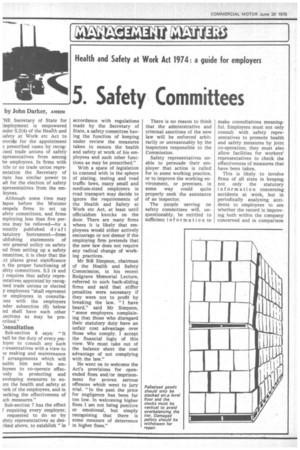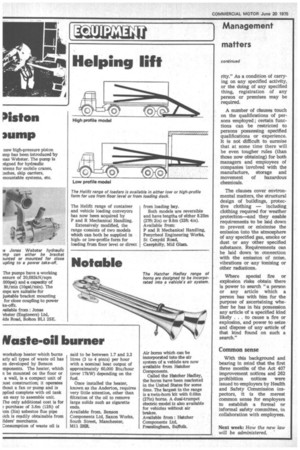5. Safety Committees
Page 104

Page 105

Page 106

If you've noticed an error in this article please click here to report it so we can fix it.
by John Darker, AMBIM 'HE Secretary of State for :mployment is empowered inder 5.2(4) of the Hearth and iafety at Work etc Act to irovicte for the appointment a prescribed cases by recogLised trade unions of safety epresentatives from among he employees. In firms with ttle or no trade union repreentation the Secretary of tate has similar power to all for the election of safety epresentatives from the emloyees.
Although some time may lapse before the Minister ampels firms to set up afety committees, and firms mploying less than five perons may be relieved—by a .?.cently published draft tatutory Instrument—from ublishing statements of ieir general policy on safety nd from setting up a safety ommittee, it is clear that the .ct places great significance n the proper functioning of afety committees. S.2 (4 and ) requires that safety repremtatives appointed by recogised trade unions or elected y employees "shall represent le employees in consultaons with the employers nder subsection (6) below nd shall have such other mctions as may be precribed."
:on sultation
Sub-section 6 says: "It hall be the duty of every -emloyer to consult any such nresentatives with a view to ie making and maintenance f arrangements which will nable him and his emloyees to co-operate effecvely in promoting and eveloping measures to enire the health and safety at rork of the employees, and in aecking the effectiveness of ich measures."
Sub-section 7 has the effect I requiring every employer, requested to do so by tfety representatives as des;ibed above, to establish "in accordance with regulations made by the Secretary of State, a safety committee having the function of keeping under review the measures taken to ensure the health and safety at work of his employees and such other functions as may be prescribed."
With a spate of legislation to contend with in the sphere of plating, testing and road traffic laws, many small and medium-sized employers in road transport may decide to ignore the requirements of the Health and Safety at Work etc Act, at least until officialdom knocks on the door. There are many firms where it is likely that employees would either actively encourage or not demur if the employing firm pretends that the new law does not require any radical change of working practices.
Mr Bill Simpson, chairman of the Health and Safety Commission, in his recent Redgrave Memorial Lecture, referred to such back-gliding firms and said that stiffer penalties were necessary if they were not to profit by breaking the law. "I have heard," said Mr Simpson, "some employers complaining that those who disregard their statutory duty have an unfair cost advantage over those who comply. I accept the financial logic of this view. We must take out of the balance sheet the cost advantage of not complying with the law."
He went on to welcome the Act's provisions for openended fines and/or imprisonment for proven serious offences which went to jury trial. "In the past the price for negligence has been far too low. In welcoming higher fines I am not being punitive or emotional, but simply recognising that there is some measure of deterrence in higher fines." There is no reason to think that the administrative and criminal sanctions of the new law will be enforced arbitrarily or unreasonably by the inspectors responsible to the Commission.
Safety representatives unable to persuade their employer that action is called for in some working practice, or to improve the working environment, or premises, in some way could quite properly seek the assistance of an inspector.
The people serving on safety committees will, unquestionably, be entitled to sufficient information to make consultations meaningful. Employers must not only consult with safety representatives to promote health and safety measures by joint co-operation; they must also allow facilities for workers' representatives to check the effectiveness of measures that have been taken.
This is likely to involve firms of all sizes in keeping not only the statutory information concerning accidents at work, but in periodically analysing accidents to employees to see whether the record is improving both within the company concerned and in comparison with similar firms in the industry. The maintenance of accurate accident records in road transport could pay off —if the record is favourable —in lower insurance premiums.
5.2(5) of the Act calling for safety committee elections in non-union firms was included against the wishes of the Government, following a House of Lords amendment. This followed a debate in which there were some sharp criticisms that by allowing appointments by recognised trade unions the Secretary of State was limiting his potential influence in the Health and Safety field. In any case, there were examples of effective joint consultation on safety matters in non-union firms.
Labour Law
In the consultative document on the Employment Protection Bill, the Government declared that 5.2(5) of the Health and Safety at Work etc Act will be deleted. This seems somewhat perverse but the Secretary of State has the power to define what is meant by a "recognised trade union" and it is pretty clear that this does not necessarily mean a trade union recognised by the employer.
It is expected that labour law in future will regard unions as deserving of recognised status if their recognition has been recommended by the Advisory, Conciliation and Arbitration Service. This means, presumably, that if the Secretary of State believes that certain trade unions ought to be recognised in a particular establishment —whether or not they have a substantial membership— then such unions would be entitled to appoint safety representatives in prescribed circumstances.
In practice, it is likely that a trade unions' local membership would elect one or more safety representatives, despite the Act's reference to such people being "appointed." If a district official of a trade union leaned heavily on his local membership to choose a particular person as a safety representative he could well face difficulties if they preferred to elect their own spokesman, or woman.
What would safety committees concern themselves with? They would have to agree a constitution, probably on lines acceptable to the Commission, with agreed numbers of management and workforce representatives— and defined objectives. The secretarial work of the committee could be undertaken by a management representative, by joint secretaries—one from each "side "—or by alternate secretaries taking one year with another.
The precise ambit of the committees will obviously not be known at the outset. It will depend on the general climate of opinion on health and safety matters in industry generally and in particular industries, especially those with a poor safety record.
There is an obscure reference in the Act (S.24 and 5) to "such other functions as may be prescribed." I have little doubt that safety committees will bring about a revolutionary growth in joint consultation generally. Companies which have formal or informal, regularly meeting, joint management/worker committees should have no difficulty in coping with safety committees which could, very sensibly, serve as sub-committees of the existing machinery. But where there is no tradition of joint con sultation—d cap i te the Code of Practice of the Industrial Relations Act of 1971— safety committees will almost certainly bring about a considerable extension of what might be termed "joint management," though managers cannot divest themselves •of responsibility in law.
There are clues to the possible meaning of "such other functions as may be prescribed " in Schedule 3 of the Act which specifies the scope of matters which may be dealt with in health and safety regulations. Schedule 3 does not relate specifically to transport but several clauses of the Schedule show the immense powers now held in reserve by Government affecting transport.
Powers held in reserve include the power to prohibit or regulate the transport of articles or substances of any specified description. Requirements may be imposed "with respect to the manner and means of transporting articles or substances of any specified description, including requirements with respect to the construction, testing and marking of containers and means of transport and the packaging and labelling of articles Or substances in connection with their transport."
Sweeping licensing powers are held in reserve. Any spedified 'activity can be prohibited " except under the authority and •in .accordance with the !terms of a licence, or except With the consent or approval ice a spedified autho rity." As a condition of carrying on any 'specified activity, or the doing of any specified thing, registration of any person 'or premises may be required.
A number of clauses touch on the qualifications of persons employed ; certain functions can be restricted to persons possessing spedified qualifications or experience. It is not difficult to surmise that at some time there will be even tougher rules (than those now obtaining) for both managers and empioyees of companies 'involved with the manufacture, storage and movement of hazardous chemicals.
The clauses cover environmental matters, the 'Structural design of buildings, protective cidthing — 'including Clcithing required for weather prckedtion—and they enable requirements to be laid down to prevent or minimise the emission into the !atmosphere of any specified gas, smoke or dust or any other specified substance. Requirements can be laid down in connection With The emission Of noise, vibrations or any lionising or Other radiations..
Where special fire or explosion risks obtain there is power to -search "a person or any article Which a person has with him for the purpose of ascertaining Whether be has in his possession any article Of a 'specified kind likely. . . to cause a fire or exploSion, and power to seize • and dispose of any article of that kind found on such a search."




























































































































































